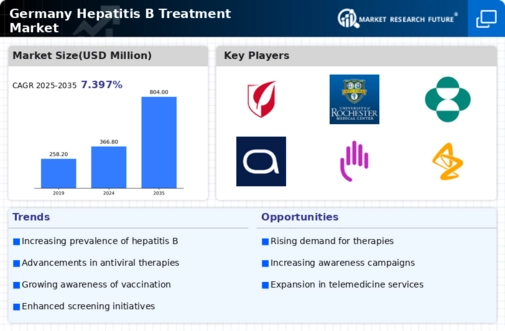Rising Prevalence of Hepatitis B
The increasing prevalence of hepatitis B in Germany is a critical driver for the hepatitis b-treatment market. Recent estimates indicate that approximately 0.5-1.0% of the population is chronically infected with the virus. This growing patient population necessitates effective treatment options, thereby propelling market growth. The healthcare system is under pressure to provide adequate care and management for these patients, which includes antiviral therapies and regular monitoring. As awareness of hepatitis B rises, more individuals are seeking diagnosis and treatment, further expanding the market. The demand for innovative therapies and comprehensive care strategies is likely to increase, as healthcare providers aim to improve patient outcomes and reduce the long-term complications associated with chronic hepatitis B infection.
Advancements in Treatment Options
The hepatitis b-treatment market is experiencing a surge in advancements in treatment options, which is a significant driver of growth. Recent developments in antiviral therapies, including nucleos(t)ide analogs and interferon-based treatments, have shown improved efficacy and safety profiles. These innovations are crucial for managing chronic hepatitis B infections and reducing the risk of liver-related complications. The introduction of long-acting formulations and combination therapies may further enhance treatment adherence and patient outcomes. As healthcare providers in Germany adopt these new therapies, the market is likely to expand, driven by the demand for more effective and patient-friendly treatment regimens. The ongoing research and development efforts in this area suggest a promising future for the hepatitis b-treatment market.
Increased Awareness and Education
Increased awareness and education regarding hepatitis B are pivotal in shaping the hepatitis b-treatment market. Public health organizations and non-profits are actively working to educate the population about the risks and consequences of hepatitis B. This heightened awareness leads to more individuals seeking testing and treatment, thereby driving market growth. Educational campaigns targeting healthcare professionals also play a vital role in improving diagnosis rates and treatment initiation. As more people become informed about the importance of early intervention, the demand for effective treatment options is likely to rise. This trend indicates a shift towards proactive management of hepatitis B, which could significantly impact the market dynamics in Germany.
Government Initiatives and Funding
Government initiatives aimed at combating hepatitis B significantly influence the hepatitis b-treatment market. In Germany, public health campaigns and funding for research and treatment programs are on the rise. The government has allocated substantial resources to enhance screening, vaccination, and treatment accessibility. For instance, the introduction of national guidelines for hepatitis B management has streamlined treatment protocols, encouraging healthcare providers to adopt best practices. This proactive approach not only raises awareness but also facilitates early diagnosis and treatment, which is crucial for controlling the disease's spread. The financial support from the government is expected to bolster the market, as it enables the development of new therapies and improves patient access to existing treatments.
Technological Innovations in Healthcare
Technological innovations in healthcare are transforming the hepatitis b-treatment market. The integration of telemedicine, electronic health records, and mobile health applications is enhancing patient engagement and treatment adherence. These technologies facilitate remote monitoring and consultations, making it easier for patients to access care. In Germany, the adoption of digital health solutions is on the rise, allowing for more efficient management of chronic conditions like hepatitis B. This shift not only improves patient outcomes but also streamlines healthcare delivery, potentially reducing costs associated with treatment. As technology continues to evolve, it is expected to play a crucial role in shaping the future landscape of the hepatitis b-treatment market.

















Leave a Comment